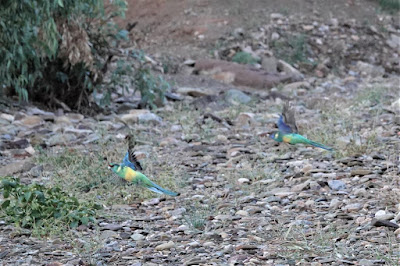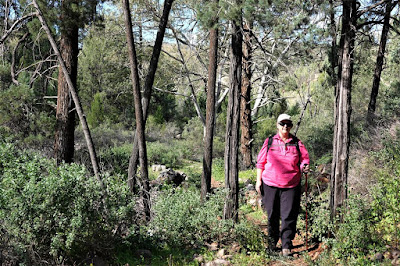Entry 3 – lock
down 4th March to 12nd June – escaping till 5th
July
On our return home 3rd March 2020 after spending
an enjoyable month travelling around Eyre Peninsula the world as we knew,
quickly changed due to the covid-19, corona virus pandemic. Airlines around the
world ceased flying as most countries closed their borders to people other than
returning citizens. Our booked flights to Canada for our planned 6 months of
exploration ceased to exist and sadly our Canada based daughter cancelled her wedding
as they asserted it wouldn’t feel right without our presence. Travel in Australia
ceased with state borders closing, and the introduction of social distancing
rules, which resulted with large volumes of businesses forced to shut down. With
the requirement to stay at home and only permitted to venture out for work, food
or medical reasons. The economy was on a downward spiral and by June the Australian
Federal Government officially announcement we were in a recession.
Once the spread of the covid-19 virus diminished with a
pending recession upon us, our state authorities decided to allow intrastate
travel to recommence, hoping this would help to give the state economy a boost.
State borders were still closed with predictions for a resumption of interstate
travel permitted, once the covid-19 virus was eliminated, Australia wide.
To be honest it was quite cosy in the comforts of our home,
especially appreciated with the onset of winter conditions. Our last home
winter experience had been back in 2012 and it was reiterated how uncomfortable
it was outside in the cold wet conditions.
It was a great reminder of how good retirement had been for
us with our focus on travel with our caravan in tow. We had been able to avoid
the southern region winter seasons and had been seeking out beautiful warm
environments all over Australia.
It had been our longest period spent at home since
retirement 2013 and we were in need of a caravan travel fix. We decided to head
around 500 kilometres north into the Flinders Ranges Region, where day time
temperatures were several degrees warmer than home. Flinders Ranges region has
a semi-arid climate with substantial less rainfall than the states southern
regions. Daytime temperatures were still cool with average temperatures in the
high teens. We had become accustomed to year-round temperatures around mid-20
to mid-30-degree centigrade and needed to assess our winter clothing attire
prior our departure.
Our first day back on the road, we managed to travel a
distance of about 350 kilometres arriving at our planned destination of Warren
Gorge located about 20 kilometres north of Quorn feeling exhausted. The sun was
getting quite low on the horizon and we immediately set off on foot searching
the gorge terrain, hoping to spot some rare yellow footed rock wallabies. We
were about to give up on our search when we spotted one. Our final count
reached 5 yellow footed rock wallabies. We were delighted and in awe of their
special colouring. It was an enchanting experience to finish our day.
 |
| the road entry point through the gorge also happened to be the best viewing location for yellow footed rock wallabies |
Warren Gorge bush campground was in the final stage of a
comprehensive refurbishment. A previous visit we found it to be uninviting with
its open sloping area. Now there were many designated camp sites each with a steel
fire ring and hot plate with delegated roadways. There were several new loo’s
scattered around the campground. The transformation of the campground certainly
bolstered this as a desirable location with a glorious setting.
There was an enjoyable circular walking trail traversing
past the camp ground with the track a few metres from our camp site.
It was time to continue onwards after a couple of nights at
Warren Gorge. Just prior to entering into our target location of Ikara –
Flinders Ranges National Park we stopped at the town of Hawker where we
replenished our fuel supplies and obtained some tourist information. It was
also possibly our last internet access and we utilized time on the internet booking
a planned campsite for our initial entry into the national park as required
under the current system. Frustratingly as so often occurring, the system kept
crashing on us and it just happened to be a weekend where the option for phone bookings
with national parks was not available. It took over an hour and about 5
attempts until we were successful.
We planned to start our experience of Ikara – Flinders
Ranges National Park from the Brachina Gorge entry point. There was still some
driving to do and we were feeling rather exhausted, mostly caused by the energy
sapping frustration dealing with a non-friendly internet system. At least the
scenery along the route was uplifting and we even got to see some eagles.
When we arrived at the Brachina Gorge entry point the
shadows were getting quite long with the sun quickly approaching the distant
horizon. Our tyre pressures were lowered, ready for the track through Brachina
Gorge which travels along a rocky creek bed for several kilometres.
The unexpected bonus of driving through the gorge at this
late time frame was to see a couple of dozen yellow footed rock wallabies along
the way as this was their more active time of the day. We found a spot to stop
for a bit to watch some wallabies until it became too dark.
 |
| entering into the great setting of Brachina Gorge driving along its rocky creek bed |
 |
| our first yellow footed rock wallaby sighting driving Brachina Gorge |
 |
| it was darker than the picture indicates |
The sun had moved on to illuminate another part of the world
when we arrived at our booked camp site. Two other sites were occupied and one
of the occupants approached us on arrival. They had arrived earlier and were
unable to get onto their allocated site and thought they may have set up on our
allocated site. Naturally there was no internet or phone reception and
reiterated just one of the many problems incurred for users over the debacle of
the present electronic booking system. We set camp right alongside of our site
number post only to find in the morning our site was another 30 metres down the
track. Grr. On a positive we got to share our neighbours fire for a couple of
nights with plenty of good conversation in a most satisfying setting.
 |
| loved the various views of our setting |
 |
| loved the various views of our setting |
 |
| loved the various views of our setting |
 |
| loved the various views of our setting |
Whilst based at Brachina Gorge we enjoyed a beautiful scenic
drive through Bunyeroo Valley, and along the Aroona Valley.
 |
| an 1800’s pug and pine hut built when sheep were introduced to this region |
 |
| an 1800’s pug and pine hut built when sheep were introduced to this region |
 |
| an 1800’s pug and pine hut built window view |
Late each afternoon we would rug up with warm clothing, load
up with our cameras and binoculars then walk from our campground into Brachina
Gorge hoping to spot Yellow Footed Rock Wallabies. The Yellow Footed Rock
Wallabies are still a rare sight and were thought to be close to extinction not
that many years prior. Our first sighting of a Yellow Footed Rock Wallaby was
at Brachina Gorge in 2015 and was our primary motivation for starting our
Flinders Ranges experience at this location. For us it has always been a
wonderful comforting experience when watching an elusive wild Yellow Footed
Rock Wallaby with their beautiful unique camouflage colouring and playful
antics. They are difficult to sight as they blend in very well with their
background location of rocky terrain. We would wander as quiet as possible
along the nearby edges of the steep rock faces on alert for any movement
helping to identify the where-abouts of a Yellow Footed Rock Wallaby.
Each late afternoon walks in the quiet tranquillity of the
bush provided other bonus sightings.
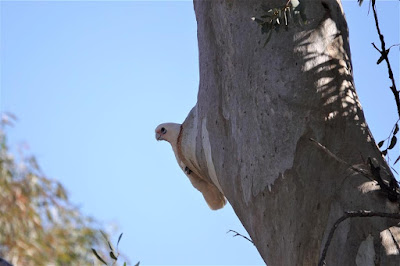 |
| I've found a good looking spot for my nest |
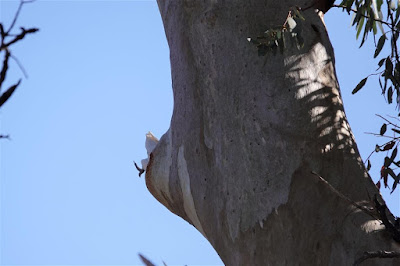 |
| yes I can reach in just nicely |
 |
| what big feet and long nose |
We do love the unique bush setting of the Flinders Ranges
with its superb flora and fauna exhibition.
 |
| I can see three I think? |
One day we decided on a driving outing where we inspected
three other nearby campgrounds, Koolamon, Aroona and Trezona. Each of these
campgrounds seemed larger than our campground location at Brachina East and we
were surprised to see them all above 50 percent capacity. For us, Brachina East
campground felt very special with its flora and fauna and as a bonus we
experienced three nights all to ourselves, viewing and listening to the enchanting
sounds of the bush without other human noise. We could have easily stayed much
longer at this location but sadly national parks had imposed a maximum stay of
5 nights.
 |
| driving out of Brachina Gorge |
For our next target location, we had decided on Italowie Gorge campground in the Vulkathunha-Gammon Ranges National Park. It was about 100 kilometres north east as the crow flies but required a drive of around 200 kilometres by road.
We headed north along the Flinders Ranges Outback Highway
towards the town of Leigh Creek. It was a Sunday and we kept an eye on our
phone in case we struck reception along our route, hoping for an opportunity to
catch up with family. Nearing Parachilna at around the 200-metre mark, we
struck a hot spot for reception and immediately stopped and happily managed to
touch base with our family members. Our family fix lasted for 1 ½ hours and we
were in need to move along hoping to arrive at our next destination prior to
night fall, deciding to leave other correspondence relating to phone messages
and emails until we next experienced phone reception.
We had read a few comments where the yellow footed rock
wallabies were present in Italowie Gorge campground ranging in numbers from a
hundred down to a few and had decided to investigate for ourselves. The sun was
about to set by the time we arrived and we immediately set off for the nearby
gorge and disappointingly only spotted one yellow footed rock wallaby hopping
away in the distance.
Up early in the morning we failed to spot any wallabies but
noted quite a few skeletal remains of yellow footed wallabies along the dry
creek bed area. After breakfast we decided to walk some of the Italowie Gorge
walking trail (about 16 kilometres, recommended 8 hours one way) which was
enjoyable walking but saddening due to sighting 30-50 yellow footed rock
wallaby carcasses along the way, (many skeletal remains were still wrapped in
yellow fur.)
Initially we thought poison or a virus may have had some
play but as we travelled further along the trail, we saw many dead trees
indicating a prolonged drought could have been the cause for so much devastation?
Italowie Gorge campground had a nice setting and was even
more enjoyable with a lovely camp fire. We enjoyed hot camp fire cooked waffles
for tea followed by beautiful camp fire roasted potatoes and onions for seconds.
We were next considering staying at Weetootla campground in
the Vulkathunha-Gammon Ranges National Park but decided to verify its
suitability with park rangers after reading some mixed reviews. The route to
Weetootla travelled past the park headquarters and we knew rangers were present
as we had pulled over to let the ranger vehicle pass us just prior arrival at
H.Q. The vehicle was parked next to the office but the office was closed. We
hung around for about half hour but for us it seemed they didn’t want to speak
with us which reiterated our personal experience with park rangers in the
Flinders region which best put in our view represents the whole of the National
Parks administration in South Australia with similarities Australia wide
(Politics!) Disappointingly we decided to skip any further viewing of the
Vulkathunha-Gammon Ranges National Park.
Down the road a bit we set camp at Chambers Gorge. It was a
location of significance for the aboriginal community with a section of
aboriginal rock carvings.
It was dry and dusty with a jarring road surface for the
initial 4 kilometres requiring a further reduction for our already low tyre
pressures.
It was a beautiful quiet location with ever changing colours
of our surroundings, created by the different angles of the sun.
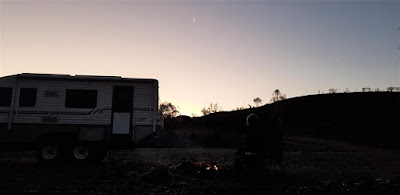 |
| look up into the sky above where the sun is setting and the moon is already visible |
It was most enjoyable seated at a camp fire with such a
beautiful backdrop. We enjoyed a campfire cooked meal of sweet potatoes, pumpkin,
onion and carrot. Delicious.
One planned night stretched to three nights at Chambers
Gorge when we needed to relocate due to self-imposed commitments.
We were travelling a complete loop from leaving
Brachina Gorge with our next planned destination at Wilpena Pound campground,
the busiest camping area back in the Ikara – Flinders Ranges National Park.
The country side on the outer perimeter of Ikara – Flinders
Ranges National Park was a dry lifeless landscape and we could feel our
adrenalin building with anticipation of returning to a magnificent landscape
when we started to see the mountain peaks appear in the distance getting
closer.
We had left early in the morning aiming for the small town
of Blinman where we managed some phone reception which provided some most enjoyable
face time chatting with our Canada based daughter and her to be husband, it may
have been mid-morning for us but it was late evening, bed time for them. It was
more pleasurable family time for us with some extra special news about their
first house purchase, cementing their future together.
Down the road a bit we set camp at the Wilpena campground
hoping for some phone reception to wish one Canberra based granddaughter a
happy 2nd birthday. Unfortunately, we had to drive a further 25
kilometres down the road to obtain phone reception where she did say hi, but
was more focused on her recent birthday presents reading aloud to herself one
new book.
Wilpena Pound has a sizeable campground area, with a large
resort accommodation centre located nearby. There are many different walking
tracks available at this location which we like, with no need to drive to view numerous
beautiful settings. Another day we walked into the edge of the pound along one
of the most scenic tracks in the Flinders Ranges. It was still reasonably quiet
with the resort closed due to the covid-19 pandemic, normally catering
predominately to the now absent overseas tourists.
We had arrived at Wilpena campground on a Friday afternoon
and had selected a camp spot to the rear a long way from other campers. It was
reiterated to us Wilpena’s close proximity to populated areas with many new
arrivals late into the Friday night and more during Saturday. Apparently we had
a gravitational pull effect about us with several new arrivals setting camp
around us. Some talked loudly late into the night. One group had a generator
running all day and into the night to power their light show and large
projector screen whom we named the Bollywood Mob. And yes, generators are not
permitted in national parks as reiterated on the paperwork provided on our
arrival.
We were up early on departure day as we had booked a morning
flight over Wilpena Pound. It was bitterly cold with the outside temperature at
zero on the 2 kilometre drive to the airport. We had booked the second flight
of the day at 9 am. Conversation with the pilot revealed it was minus 5 C on
his arrival at the airport near 8 am, with a late departure due to the need to
remove ice from the wings prior to flight.
 |
| at 8.18 am outside temperature 0 degrees and we were appreciating our car's heated seats warming our bottoms |
 |
| there’s our plane coming in to land |
Further conversation with the pilot showed at this time last
year there were four planes operating from the Wilpena airport and just to keep
one plane in operation this the year they had offered flights at
about half normal price which we did appreciate. This was our first flight
experience over Wilpena Pound and surrounding area and it exceeded all our
expectations. It was a wonderful experience.
 |
| the outer rim of Wilpena Pound |
 |
| 19th century homestead in Wilpena Pound |
 |
| St Mary's peak the highest peak in the Flinders Ranges |
 |
| coming in to land with our tow tug & caravan waiting for our return |
It was time to start our return trip home of about 450
kilometres, hoping to complete it over a five day period. Stopping at the town
of Quorn we checked the predicted weather forecast for the next five days along
our proposed route. Unfortunately there was a prediction of rain arriving in a
couple of days and we decided to skip one last night’s fix of a yellow footed
rock wallaby spotting near Quorn and continue on down the road a bit further to
Mount Remarkable National Park setting camp at Mambray Creek campground. This
is one of our favourite camp locations frequented by us many a time with our
last stay too long ago at three years past. As soon as our eyes fixed on the
setting of Mambray Creek, we felt very contented to be back at this most
magnificent scenic location.
Mambray Creek was the greenest we had ever encountered,
enhancing a most magnificent setting. We set camp in our preferred camp site
with uninterrupted views of the creek. The only thing missing was the normal
presence of kangaroos grazing between us and the creek bed. This could possibly have been due to the
amount of green feed about where they were grazing in more private locations.
We did several walks, spotting kangaroos grazing some distance from the camp
ground.
 |
| emu deposit |
We had booked for two nights at Mambray Creek which had
provided a great boost to our wellbeing and we decided to stay another night.
Unfortunately our site was not available. With a low northern sun for our
required solar energy input we walked around the campground assessing other
sites for optimum solar input. We decided to relocate on the other side of the
road from site 3 to site 4. Unfortunately the views just didn’t compare but our
batteries were happy.
Leaving Mambray Creek we decided to deviate inland a bit for
a more leisurely scenic drive, south towards home. We drove through a scenic
Port Germein Gorge. Once up on the plateau the country side changed to vast
crop paddocks.
 |
| drive through Port Germein Gorge |
 |
| healthy looking crops |
We stopped at the town of Wirrabara to view some silo art,
had a look at Laura and Gladstone, thinking they were all worthy for a day’s
exploration. But not this day with an outside temperature of around 13 C and a
strong wind chill effect creating a feel like of around 5 degrees.
We stopped for the night at the small town of Brinkworth
where we enjoyed hooking up to mains power for the first time this trip and why
wouldn’t you at $12 for the night with hot showers. We walked around town enduring the
chilly conditions for a bit of exercise. Steve’s brother best friend
lived nearby and we caught up with Kev for a good chin wag.
The following day involved about a 200 kilometre drive to
our home.
We were still coming to terms with two years of planning
for our 2020 Canada trip which has been obliterated by the coronavirus pandemic.
We had thoroughly enjoyed our Flinders Ranges experience reiterating - Life was
good.
We needed more time at home hoping to salvage some expenses
incurred for our Canada plans and set ourselves for escape to the countryside locations around Australia for the remainder of 2020.





















